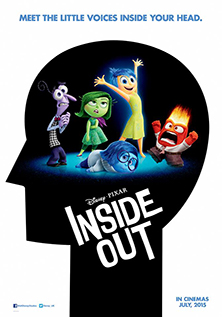Hermana’s Head (Inside Out)
We went to see Pixar’s latest, Inside Out, on a lark over the weekend. As a fan of the show that originally explored the concept in the early ‘90s, I had high hopes for Pixar’s presentation. I was generally disappointed. The film dragged a lot, not from a lack of action per se but from a lack of new things happening.
Decent Science – Dullish Movie
Inside Out is the story of the voices in a little girl’s head that control her activities and make up her personality. They are represented as emotions Joy, Sadness, Fear, Anger, and Disgust. They manage her short-term memory and operate a large panel that guides her actions. They are, literally, her drivers. The emotions interact like factory or office workers, alternately driving, reacting to the girl’s life, or ignoring her for a moment to have some squabble of their own. Pixar devotes a significant amount of their story telling to getting little details sort of scientifically accurate, and Inside Out is no exception. The operation of the girl’s head is in line with current theories of neuroscience.
The emotions gather the day’s memories in a somewhat disorganized fashion, until she sleeps, when the marbles are packed off to long-term storage. A selection of memories are, with no apparent rational, branded “core” memories, and these make up the pillars of her personality – Goofball, Hockey, Honesty, and Family islands connected between long-term memory and the operations center.
In the course of the story, the girl’s family moves from Minnesota to San Francisco. Joy tries to prevent Sadness from affecting her memories (new and old), and the pair of emotions are accidentally exiled from the control center. The resultant adventure is a sort of road movie through the other parts of the girl’s mind. It would have been a fun and interesting journey, except that the peril for the emotions is repetitive. Joy is continuously almost on her way back to central, when her plan collapses, again. The amount of damage that occurs to the girl’s brain is on the order of major head trauma.
The film is not without its moments. The film offers an explanation of getting a song stuck in your head. We get to see the control rooms of the other major characters, Mom’s version of Joy swooning about a flirtation with a Brazilian Helicopter Pilot, Dad’s team checks out of a conversation to watch a memory of a sporting event. There is a wonderful montage at the end showing the operations centers of incidental characters. The problem is we have to wade through Joy failing and watching a personality island collapse – again – in order to get to these moments.
Inside Out is not a return to Pixar’s glory days (Toy Story, Monster’s Inc., or Finding Nemo). It is smart in concept, but it seems too slow and cerebral for the usual target audience. It is probably worth a watch when it makes the rounds on “cable,” but not as a babysitting film.